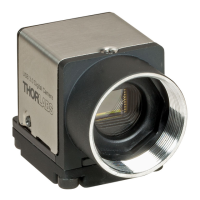© 2016 Thorlabs Scientific Imaging
3 Operation
69
When enabling the rolling or global shutter mode the black level is set to a fixed factory-provided
value. Therefore, the black level can individually adjusted after switching the shutter mode.
Depending on the internal black level and shutter mode the offset control shows no additional
cumulative effect at the top.
The factory setting of the offset control are so selected that the black level is always slightly
increased to avoid losing image information by cutting underneath the origin. For linearity
measurements the black level must be adjusted to the origin with the offset control before the
measurement is done.
Color sensor
The color sensor's black level cannot be adjusted manually, as the RGB gains are downstreamed
and an adjustment would cause color errors.
Automatic black level correction is always enabled.
The RGB gains work analog.
The fast line scan mode is disabled.
NIR sensor
It is recommended to use a IR-coated and IR-corrected high-quality lens, especially for non-
monochromatic light.
In the high IR wavelength range picture blur can occur with strong contrasts. This reduced MTF
(modulation transfer function) is a characteristic of the sensor pixels.
The master gain of the NIR sensor is adapted in comparison to the monochrome sensor. If both
sensors are compared directly, the gain of the NIR sensor must be set to the double factor of the
monochrome sensor. This can be done via the master gain or the gain boost.
In the Log mode the guaranteed dynamic range of the NIR sensor is reached with a gain value of
at least 1. For the monochrome sensor you need at least a value of 3. With very short exposure
times, lower values can result in even higher dynamics.
Gain, pixel clock
Master gain uses a combination of coarsely scaled analog gain factors and finer digital scaling.
To achieve optimum homogeneity of the gray level, use only the gain factors 0, 33, 66, and 100.
The gain boost has the factor 2. When using the master gain a maximum factor of 8 is possible
caused by the sensor.
For global shutter mode the pixel clock should be set to the maximum possible value to increase
the image quality.
In the 10 bit mode the usage of the digital gain intermediate level produces missing pixel values
as the sensor works internally with maximally 10 bit.
Hot pixel
In the rolling shutter mode, there are less hot pixels, as the pixel charges are not buffered in the
sensor.
The sensor corrects hot pixels dynamically. Neighboured hot pixels in diagonal direction cannot
be corrected effectively. These positions are covered by the factory-made hot pixel correction
and are eliminated by the software hot pixel correction. Therefore, the hardware hot pixel
correction is a prerequisite and should not be deactivated.
On the color sensor the hot pixel correction works with the appropriate color neighbours.
In the global shutter mode, increased hot pixels can become visible in the lower image area with

